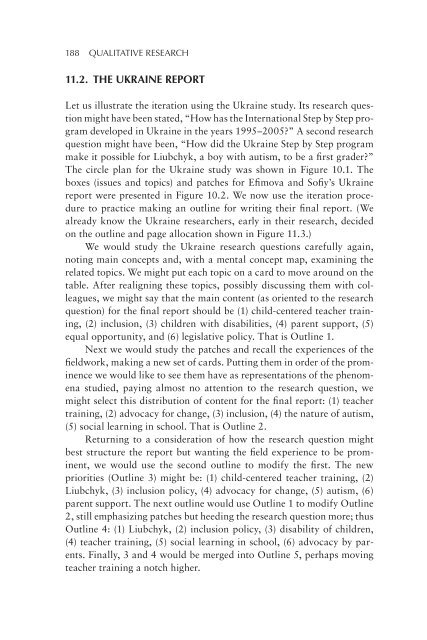How Things Work - Doha Academy of Tertiary Studies
How Things Work - Doha Academy of Tertiary Studies
How Things Work - Doha Academy of Tertiary Studies
Create successful ePaper yourself
Turn your PDF publications into a flip-book with our unique Google optimized e-Paper software.
188 QUaLItatIVe ReSeaRCH<br />
11.2. the uKRaiNe RePORt<br />
Let us illustrate the iteration using the Ukraine study. Its research question<br />
might have been stated, “<strong>How</strong> has the International Step by Step program<br />
developed in Ukraine in the years 1995–2005?” A second research<br />
question might have been, “<strong>How</strong> did the Ukraine Step by Step program<br />
make it possible for Liubchyk, a boy with autism, to be a first grader?”<br />
The circle plan for the Ukraine study was shown in Figure 10.1. The<br />
boxes (issues and topics) and patches for Efimova and S<strong>of</strong>iy’s Ukraine<br />
report were presented in Figure 10.2. We now use the iteration procedure<br />
to practice making an outline for writing their final report. (We<br />
already know the Ukraine researchers, early in their research, decided<br />
on the outline and page allocation shown in Figure 11.3.)<br />
We would study the Ukraine research questions carefully again,<br />
noting main concepts and, with a mental concept map, examining the<br />
related topics. We might put each topic on a card to move around on the<br />
table. After realigning these topics, possibly discussing them with colleagues,<br />
we might say that the main content (as oriented to the research<br />
question) for the final report should be (1) child- centered teacher training,<br />
(2) inclusion, (3) children with disabilities, (4) parent support, (5)<br />
equal opportunity, and (6) legislative policy. That is Outline 1.<br />
Next we would study the patches and recall the experiences <strong>of</strong> the<br />
fieldwork, making a new set <strong>of</strong> cards. Putting them in order <strong>of</strong> the prominence<br />
we would like to see them have as representations <strong>of</strong> the phenomena<br />
studied, paying almost no attention to the research question, we<br />
might select this distribution <strong>of</strong> content for the final report: (1) teacher<br />
training, (2) advocacy for change, (3) inclusion, (4) the nature <strong>of</strong> autism,<br />
(5) social learning in school. That is Outline 2.<br />
Returning to a consideration <strong>of</strong> how the research question might<br />
best structure the report but wanting the field experience to be prominent,<br />
we would use the second outline to modify the first. The new<br />
priorities (Outline 3) might be: (1) child- centered teacher training, (2)<br />
Liubchyk, (3) inclusion policy, (4) advocacy for change, (5) autism, (6)<br />
parent support. The next outline would use Outline 1 to modify Outline<br />
2, still emphasizing patches but heeding the research question more; thus<br />
Outline 4: (1) Liubchyk, (2) inclusion policy, (3) disability <strong>of</strong> children,<br />
(4) teacher training, (5) social learning in school, (6) advocacy by parents.<br />
Finally, 3 and 4 would be merged into Outline 5, perhaps moving<br />
teacher training a notch higher.

















